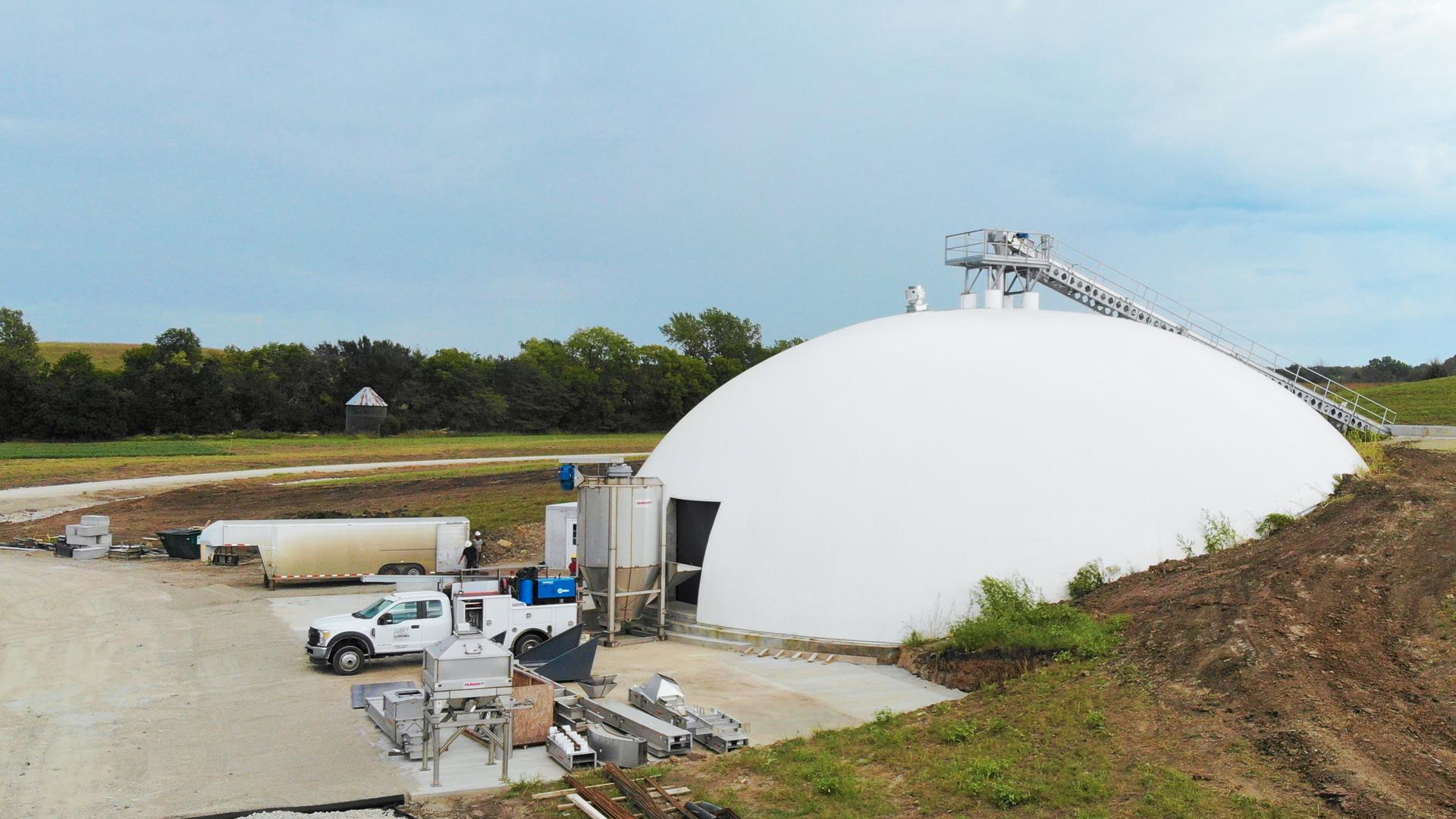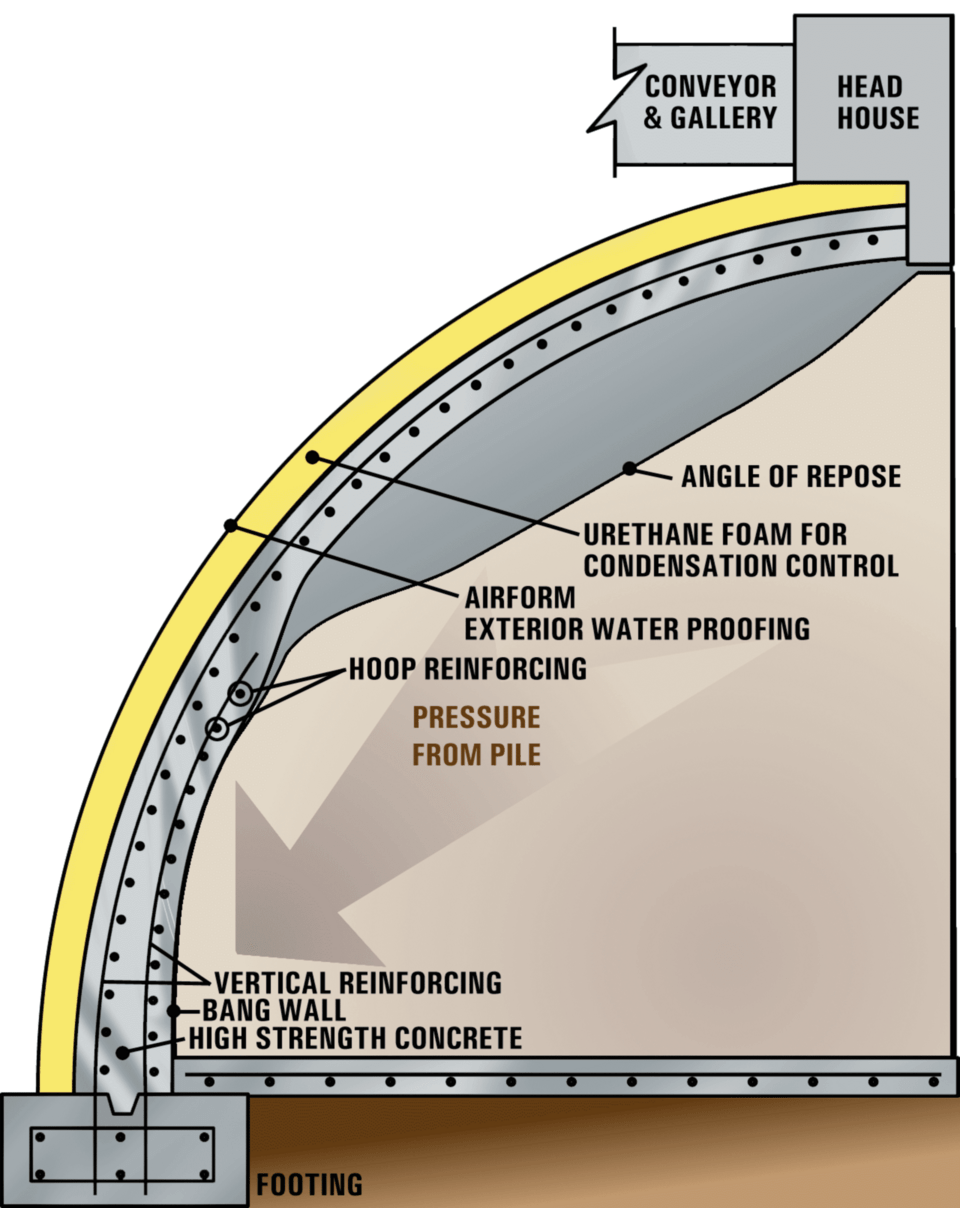Monolithic Dome Storages

The Jackson Farmers Fertilizer Blend Plant near Holton, Kansas, stores 3,000 tons of fertilizer products across seven storage bins.
The first Monolithic Dome was a potato storage constructed in 1976 in Shelley, Idaho. The 105-foot (32 m) diameter by 35-foot (10.7 m) tall dome stored 3,200 tons (2,900 t) of potatoes in an optimal environment of humidity and temperature. The dome exceeded all expectations and kicked off the Monolithic Dome industry.
Storages are the most popular use of the Monolithic Dome. In fact, the number of storage domes is greater than all other applications—combined. There are tiny storages only 10-feet (3 m) diameter containing household supplies to gigantic storage domes over 340-feet (100 m) diameter storing more than 100,000 tons (90,000 t) of bulk material. Many sites have multiple domes in multiple configurations with huge, automated product reclaimers and material handling systems. There are Monolithic Dome storages on every continent (well, except Antarctica), and they store so many different products that we can only list a few highlights.
- Food—There are large grain storage domes for wheat, barley, corn, sugar, and other dry food supplies along with specialized food storages for products like peanuts, apples, and—of course—potatoes.
- Fertilizer—The variety and size of dome fertilizer storages range from small retail blend plants to massive single purpose domes storing thousands of tons of bulk fertilizer components like ammonium nitrate, potash, phosphate, urea, and more.
- Raw materials—Other dry bulk materials stored in domes include frac sand, gypsum, cement, copper, fly ash, iron carbide, coke, limestone, and so much more—like wood pellets. Projects range from small salt storages next to highways across the midwest to huge, multi-dome facilities at major ports.
- More storages—There are water tanks, freezers, refrigerators plus a wide variety of small domes used for manufacturing and storing inventory. There is even a disaster safe shelter to store computer data.
The flexibility and strengths of the Monolithic Dome are apparent as its use grows across all industries. It may seem arrogant to claim a structure can be so versatile, but there are concrete reasons why.
Strong and flexible design

Cross-section diagram of common Monolithic Dome bulk storage features. The equipment head-house is supported by the dome with no columns underneath. The stored, bulk product piles against the dome wall designed to resist the enormous pressure.
Whether a dome is 30-feet (9 m) or 300-feet (91.5 m) diameter, the fundamental construction process is the same. There are no “standard” sizes for diameter, height, or shape. Each structure is individually tailored for the needs of the stored material and project site. Some products store better in tall, domed silos while a different product is better in piles under a low-profile dome. All Monolithic Domes are free span structures leaving the interior free of design constraints in product placement, management, and retrieval.
Domes are strong. Exceptionally strong. Need an equipment head house weighing 250 tons (227 t) on top of the dome to store cement piled high against the interior dome wall? No problem. Add two layers of steel rebar in the concrete shell and add integrated support for the head house. The dome supports the handling equipment without sacrificing the free span interior—maximizing storage volume while using less land and less equipment.
What about a fertilizer blend plant with spray-in-place concrete bin walls, a rotating polar conveyor, and a simple delivery elevator? No problem.
How about a salt storage dome with an angled entrance to reduce the “corners” and allow free access for front end loaders? Done.
What if the front end loaders “bang” into the dome wall? Don’t worry, it’s tough. If needed, a little extra concrete can create “bang walls,” but drivers rarely hit the walls more than a few times because the dome doesn’t move—it’s the driver who gets a jolt.
There are as many variations in storage domes as there are products, companies, and project sites.
Less cost with quick all-weather construction
Mathematically, a dome encloses the maximum volume using the least material. Therefore, a Monolithic Dome will generally hold more material for less money and use less land to do it. This efficiency only improves when storing more product volume. Sometimes a single dome can safely store the same total quantity as multiple conventional storage buildings—further reducing costs for equipment and material handling.
The Monolithic Dome building process is incredibly efficient. A modest crew can construct a large structure using mostly raw materials from local sources. Once the Airform membrane is inflated and stabilized, construction continues inside the dome, away from the weather. Weather delays are reduced, and crews can finish the storage in a timely manner.
Safety for products and people
A Monolithic Dome is incredibly safe. Fires, hurricanes, tornadoes, earthquakes, the Monolithic Dome has survived them all. The product is protected from these disasters as a natural benefit of the structure’s steel-reinforced, concrete construction.
Conversely, the dome protects people from the product. Even non-hazardous materials like wheat can catch fire and cause extreme danger to people working and living around a structure. A Monolithic Dome concrete interior will not burn and adds no additional fuel to the fire. If the worst happens, a Monolithic Dome is naturally blast-resistant and can be designed to vent explosive gasses away from people and property.
That’s assuming a fire can start at all. Dangerous circumstances outside a dome rarely threaten the product inside.
Monolithic Dome ammonium nitrate storages, for example, are naturally protected if a nearby building were to catch fire. And carefully designing the ammonium nitrate storage to exhaust an internal explosion will protect employees and neighbors if the unthinkable happens—which is unlikely because of how safely the dome stores the ammonium nitrate in the first place.
Better than insurance
As a disaster-resistant, virtually fireproof structure, the Monolithic Dome generally lowers insurance premiums—saving money year after year. However, the best insurance is one that’s never needed.
More than just a building and product are lost when disaster strikes a conventional structure. Business grinds to a halt. Customers must look for resources elsewhere. The cash stops flowing. Insurance adjusters visit, and eventually, money is released. The structure is rebuilt. But can the business survive the downtime? Will the customers return?
A Monolithic Dome that survives the same disaster with minimal damage can get back to work quickly. Business continues. Customers stay.
Being prepared for a disaster is better than insurance.
Condensation, climate, and corrosion control
The outside of a Monolithic Dome is the Airform membrane left in place when construction is finished. It is a waterproof, single-ply roofing membrane. Underneath that are several inches of polyurethane foam—which is also waterproof—that insulates the innermost layer of steel-reinforced concrete. The thermal mass of the concrete—protected from outside weather by the foam—maintains an even, average temperature. The result is minimal condensation and a better interior climate—without HVAC equipment.
In humid environments or when the stored product is especially sensitive to humidity, it’s now affordable to add HVAC equipment to dry the air. There are several fertilizer blend plants with cheap, “window” air conditioning units installed that have all but stopped equipment rusting, product caking, and facility corrosion.
Shotcrete—the sprayable form of concrete used to construct Monolithic Domes—is extraordinarily dense and more chemically resistant than regular concrete. It better withstands the corrosive effects of some bulk products that typically “eat” regular concrete. In some cases, additives can be used to increase corrosion resistance. There are storage domes, decades-old, still in use with minimal, if any, concrete corrosion.
Next steps
The Monolithic Dome Institute has deep experience across the storage industry. MDI can connect you with industry experts who give practical advice and even initial designs for various storage projects.
We provide an initial evaluation for free and without obligation—we mean it, we are too busy to bother people who are not interested. Fill out this Free Monolithic Dome Storage Evaluation form, and we will respond with real-world information for your potential project.